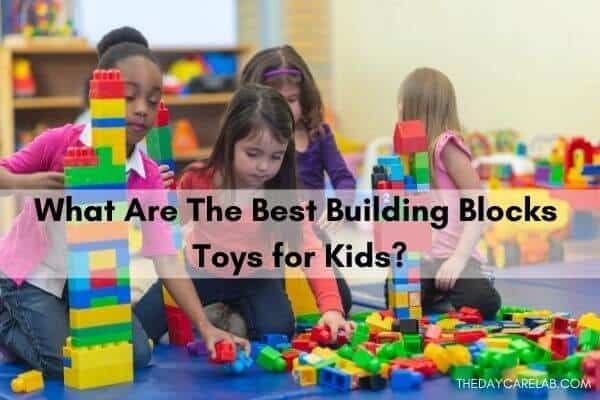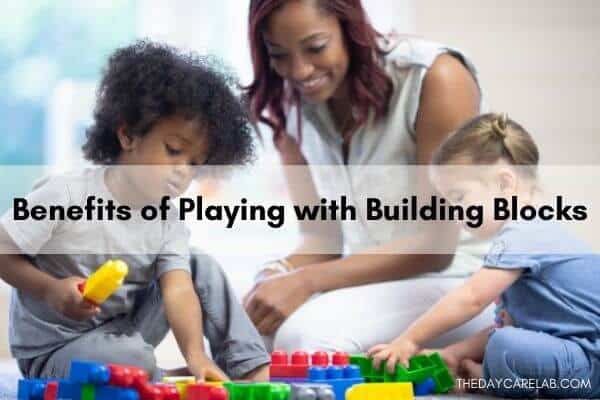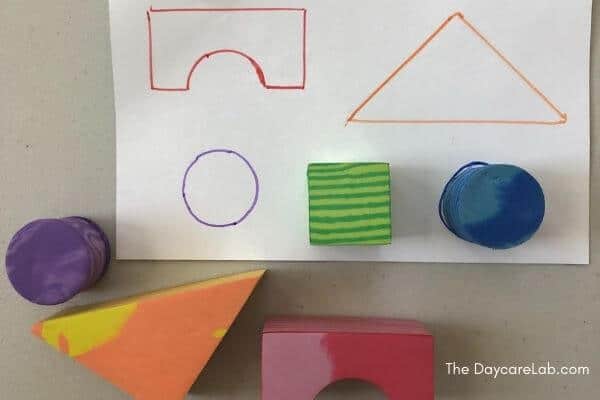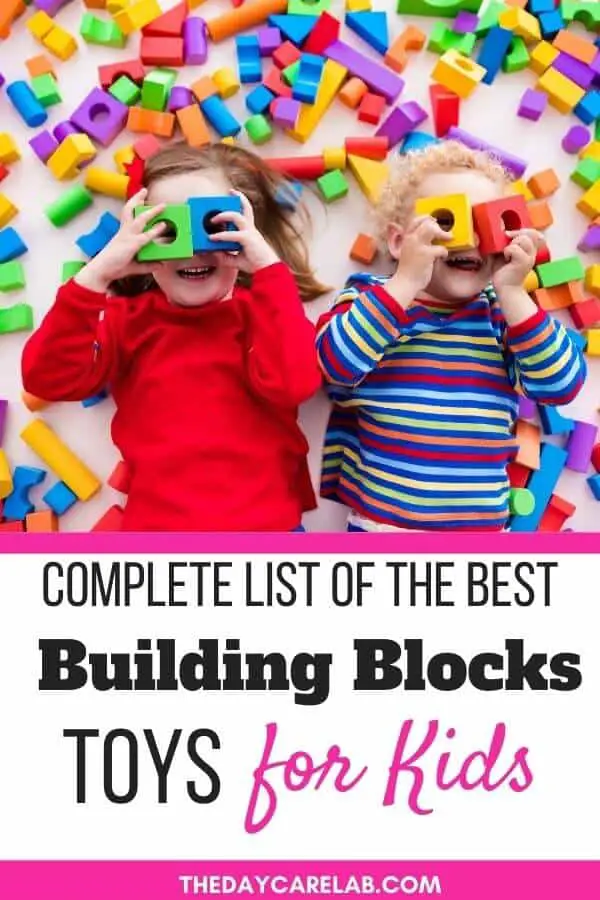Let’s talk about the best building blocks toys for kids and the benefits of creating a quality block center.
There are dozens of building block toys to choose but quantity is not what makes a quality play center.

You might have reasons to want to limit the number of block sets you bring into your space and minimize spending.
Especially when it comes to buying new toys and equipment for a daycare business or even as a parent, it’s wise to only focus on a few quality block toys at a time.
- What are the benefits of building blocks?
- How to set up a building block learning center for kids?
- How many building block sets does a block center need?
- At what age should a child be able to build with blocks?
- How do you play with building blocks?
- What are the best building blocks for kids?
- Complete List of The Best Building Blocks Toys
- Props For Block Play
✅ But if you’re curious (or in a hurry)…
Check out the Complete List of The Best Building Blocks Toys (HERE). This list will help you take a quick look at what items you need to set up a quality block center for your child’s playroom or child care program.
When I started my home daycare business, I had to figure out what building blocks I REALLY needed in my my block area. I was about to start a new business on a budget, and that budget was tight.
What I figured out was this: the children only need a few sets of basic building blocks, a place for them to build and play uninterrupted.
Once all that is in place, then you can add more block sets and whatever else you have room for in your budget.
Related: Best Art Supplies for Toddlers and Preschoolers
Before we get into the best building blocks to have in your block center (or playroom), let’s talk about the benefits of playing with building blocks.

What are the benefits of building blocks?
Building blocks are fun and have always been a favorite toy among children of all ages.
But did you know that building blocks provide several developmental benefits?
Yes, it’s true!
Through the humble building block children can learn about colors, shapes, numbers, length, weight, area, patterns, etc. and other mathematical concepts.
But that’s not it!
Children learn social skills when playing blocks with other children. They learn how to share, communicate with others and build leadership skills.
Also, block play will improve hand-eye coordination. It takes patience, focus and balance for a child to be able to grip objects, bring them together and build something amazing with it.
Let’s not forget building blocks encourage creativity and build imagination.
How to set up a building block learning center for kids?

Ideally, the best spot for a building block center is in the corner of the room, surrounded by two corner walls and a storage cabinet like the one here or couch perpendicular to one wall. Doing this will create an enclosed space of three sides.
If this setup is not possible, then look for a place that doesn’t get too much foot traffic from the other children. The younger kids love knocking down block structures, but it’s unfair for the children building them.
So you need to find a space where the children can build comfortably. And where you can store a variety of blocks.
Use plastic tubs, baskets, milk crates, cardboard boxes or anything you can use from around your house to keep the blocks separate and organized.
How many building block sets does a block center need?
There isn’t a right or wrong answer because the number of block sets you should add to your block space will depend mostly on your budget, space availability, and tolerance for toys scattered across the floor. But in my opinion, two or three different building block sets are a good start.
Always keep in mind the developmental stage of the child when selecting your blocks.
At what age should a child be able to build with blocks?
Block play happens in stages and children as young as a few months can start playing with building blocks.
Infants start playing with building blocks by exploring them through their senses. They enjoy putting blocks in their mouth, squeezing them, banging them together or on other hard surfaces.
Older infants and toddlers love picking up blocks, dropping them, putting them into containers, and moving them around from place to place.
Preschool and older children will create elaborate structures and use them as settings in their dramatic play.
How do you play with building blocks?
Building blocks are an open-ended toy, so the play possibilities are endless! Meaning there is no right or wrong way to play with building block toys. Children can play with them however their imagination allows.
And as an early childhood teacher, I too can come up with many engaging games and activities for the kids using building blocks.
For instance, I create mini matching games for the children. I trace a few blocks on cardstock and have the children match the shape to the drawing.

But almost always, while the children play, I observe, and I ask them open-ended questions.
- Tell me about….
- I noticed…
- What would happen if…?
- How would you…?
- How did you…?
- What else could you try…?
- Why did you choose…?
Example:
Why doesn’t your tower fall down?
I noticed you used the same number of blocks to build both towers, but why is one taller than the other?
What will the animals do inside the zoo you built?
What are the best building blocks for kids?
Blocks come in different sizes, shapes and materials. You can get spongy blocks, wooden blocks, plastic blocks, and even blocks made out of recycled cardboard boxes.
Prices for blocks depend on the material used to make them. Blocks made of soft materials usually cost less than the ones made out of hardwood.
Okay, now that I got that out of the way.
Let’s go on to the list of the best building block toys and all that fun stuff!
(These are in no particular order.)
Complete List of The Best Building Blocks Toys
Best Colorful Wooden Blocks

This set of wooden blocks adds a pop of color to your block center.
They’re perfect for curious minds, and as you may know, that’s almost every child in their early years. The kids can learn all about shapes, color recognition, matching, stacking, fractions, etc.
Best Solid-Wood Unit Blocks

Solid-wood building blocks like these are a classic toy. And since they’re made of solid-wood, they don’t break or chip easily.
Since they come in natural wood color, the kids will focus mainly on the shape of the blocks as they create new worlds for their dolls, animals, cars, etc.
Best Builder Blocks

These Mega Bloks are perfect! They are colorful and big enough for even the littlest of kids to use.
Children love putting them together to create new things from around their world and pulling them apart to build new things all over again.
Best Geometric Wooden Blocks

Oh, these blocks are so cool! Kids love looking through the color section of the blocks and stacking them together. Also, they’re perfect to use on top of a light table like this one here or near a sunny window.
You can combine them with another set of blocks like the solid-wood block set I mentioned above.
The kids will love answering questions like “what happens when you put a yellow block over a blue block?”
Best Jumbo Carboard Blocks

These jumbo cardboard blocks take up a bit more space to store, but the kids’ love, love, LOVE THEM! These Melissa & Doug Jumbo Extra-Thick Cardboard Building Blocks are sturdy and long-lasting.
However, I’m going to share something with you that I thought was pretty cool.
My local library created its version of jumbo blocks using yoga blocks similar to the ones here. The upfront cost is more, but these blocks will last a very long time and will be strong enough for kids to constantly sit or stand on them.
But don’t worry if you don’t have the investment to recreate the jumbo blocks out of yoga blocks. The Melissa & Doug Jumbo Extra-Thick Cardboard Building Blocks are a great choice and best of all, budget-friendly!
Best Stacking Cubes

Stacking blocks like these are great for children to learn about sizes and they are available in wood or cardboard.
I prefer these cardboard stacking cubes because they’re lightweight, and they cut down on the noise created by knocking down the tower of blocks. However, the wooden stacking cubes will last longer.
The most common uses for these stacking cubes are building a tower from biggest to smallest block, nesting them together, and using them to hide toys.
Best Building Blocks for Infants

When introducing building blocks to infants, these building blocks are my favorite. They are softer than wooden blocks. So if a child throws them or chews them, I don’t have to worry about them hurting anyone else or themselves.
Also I can easily wash them off with a disinfectant wipe or in the sink with soapy water.
Each block has a specific number on it, a picture of an animal and are colorful.
Not only are these blocks a great tool to teach children about colors, animals, shapes and numbers.
Also, the kids love stacking them and knocking them over without making a loud noise.
Learn more about the best toys for 1 year olds right now.
Best Alphabet Blocks

No block center is complete without a set of classic ABC building blocks.
Besides the usual stacking of blocks, this set of blocks is perfect for letter and number recognition, phonics, color sorting, counting, and simple math problems.
I don’t know about you, but I love toys that I can continue to use with the kids as their skill levels grow.
Another thing I like about this specific set of ABC blocks is they are larger than most of the more common ABC blocks for sale.
Best Bristle Blocks

This is another great building toy to add to your block center. The children stay busy playing with them for a long time and it’s a nice change from building with wooden blocks or cubes.
Also, Bristle Blocks are great in helping kids develop fine motor skills every day.
Best Magnetic Building Blocks

They’re magnetic, transparent, and great for building on and off a light table. As of now, I haven’t met a child who doesn’t love these magnetic building blocks.
Props For Block Play
Don’t forget to add a few prop toys! Children can use simple props to turn their structures into castles, zoos, farms, etc.
Here’s a small list of props you can add to your building block center:
- Small cars with miniature traffic signs

2. Small wooden or plastic figures of people

3. Animal figures (farm animals, jungle animals, dinosaurs, etc.)

I hope my list helps you create a fun building blocks center for your children.
Let me know in the comments if I missed your best building blocks toys must haves or if you want to add anything to the conversation.
Pin for later!


Leave a Reply